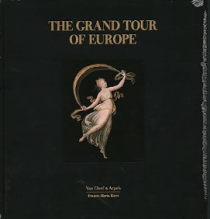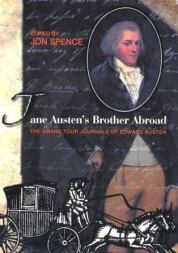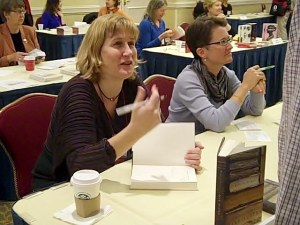“Jane and her family simply had to put up with the small aches and ailments of life.” – Lucy Worsley, Jane Austen at Home

Cassandra Leigh Austen
When Jane Austen was seven, her mother, Cassandra Leigh Austen, lost several foreteeth, which made her look older. One can tell the absence of those teeth in this profile.
Healthy teeth and gums are signs of a good constitution. Throughout her adulthood, Mrs Austen was known for her many ailments. One wonders if there was a connection between her poor health and missing teeth. One also wonders if tooth problems were regarded as small aches and ailments of life, or something more.
In fall of 1813, Jane Austen visited her brother Henry in Henrietta Street in London, along with Edward Knight, their older brother and his three daughters, 20 year old Fanny and Lizzy (13) and Marianne (12). In two letters to her sister Cassandra, Jane described pleasurable family pastimes and shopping purchases, but her most vivid recollections are of two visits to the dentist. Her first account is of an hour-long visit to a dentist named Mr Spence. On September 15, she wrote:
“Going to Mr. Spence’s was a sad business and cost us many tears; unluckily we were obliged to go a second time before he could do more than just look. We went first at half-past twelve and afterwards at three; papa (edward) with us each time; and, alas! we are to go again to-morrow. Lizzy is not finished yet. There have been no teeth taken out, however, nor will be, I believe, but he finds hers in a very bad state, and seems to think particularly ill of their durableness. They have been all cleaned, hers filed, and are to be filed again. There is a very sad hole between two of her front teeth.”
London was apparently filled with a tribe of Mr Spences, all of whom were dentists. Braving the Dentist with Jane Austen conjectures that the individual who treated the Knight girls might be George Spence, dentist to George III. This makes sense, for Edward Austen Leigh was rich enough to afford a dentist whose career and a patented brand of tooth powder made him “wealthy enough to buy a country estate at Cranford and to see his sons well educated.”
The Regency Era was not known for gentle dentistry practices. Jane’s letter on the 16th details a harrowing scenario:
“The poor Girls & their Teeth!—I have not mentioned them yet, but we were a whole hour at Spence’s, & Lizzy’s were filed & lamented over again & poor Marianne had two taken out after all, the two just beyond the Eye teeth, to make room for those in front.When her doom was fixed, Fanny Lizzy & I walked into the next room, where we heard each of the two sharp hasty Screams.”
– Fanny’s teeth were cleaned too–& pretty as they are, Spence found something to do to them, putting in gold & talking gravely–& making a considerable point of seeing her again before winter.–He had before urged the expediency of L. & M.s being brought to Town in the course of a couple of Months to be farther examined, & continued to the last to press for their all coming to him.—My Br[other] would not absolutely promise.
—The little girls teeth I can suppose in a critical state, but I think he must be a Lover of Teeth & Money & Mischeif to parade about Fannys. I would not have had him look at mine for a shilling a tooth & double it.—It was a disagreable hour.”
I’m amazed that Mr Spence’s efforts took only an hour, for in that time he cleaned Fanny’s teeth and put in gold, pulled two of Marianne’s teeth, and filed Lizzy’s. I wonder if he gave laudanum (10% opium powder solution in alcohol) to poor Marianne. Had she taken the tincture it would not have helped her immediately, for she let out two short screams. Relief would come only 15 minutes or so later. (Nitrous oxide was not generally used as a dental anesthetic until 1844.)
As for filing Lizzy’s teeth, this was a common practice at the time (and even today) to smooth out uneven teeth. This practice achieved both good or evil results, for if too much of the tooth was filed (especially in a young person), the enamel could be significantly thinned in subsequent filings and make the teeth more sensitive. Jane used the words mischief and disagreeable to remark on Fanny’s unnecessary treatment, and emphatically wrote she would not subject herself to Mr Spence’s care.
Daily Dental Hygiene
By the late 18th century, people used a variety of means to take care of their teeth: toothpicks made with the quills of goose feathers and toothbrushes created with horsehair or hog’s hair. These implements created as many problems as they solved, for they were unsterile and distributed germs while “cleaning teeth.”
In Sense & Sensibility, Austen connected toothpicks with privilege. She described Robert Ferrars as he carefully chose a toothpick case at Gray’s jeweler’s in Sackville Street, detaining the Dashwood sisters:
‘At last the affair was decided. The ivory, the gold, and the pearls, all received their appointment; and the gentleman having named the last day on which his existence could be continued without the possession of the toothpick-case, drew on his gloves with leisurely care and … walked off with a happy air of real conceit and affected indifference’.
The jewellery shop on Sackville Street, near Regent Street, was likely well known to Jane, who frequently visited her brother Henry in central London. This scene is a reminder to Austen’s contemporaries that implements for dental hygiene, although affordable for the upper and middle classes, were unaffordable to the poor, who had to make do with whatever was at hand, such as soda ash (lake brine or naturally occurring mineral deposits) or salt. Both were clean products.
The toothpaste of that era or tooth powders were also problematic. Ian Mortimer lists a recipe in his book for white tooth powder: 60oz chalk, ½oz of cassia powder and 1oz of orris root.* Other recipes included pulverized charcoal, brick or salt. All could destroy tooth enamel.
Austen described the effects of Harriet Smith’s tooth extractions in Emma:
“Pretty little Harriet Smith was usually the most cheerful, happy natured young lady, but just now she was leaning on the sofa in a despondent, listless posture, and not seeming to even notice Isabella’s five children, who were romping at their feet, in various states of frisk and noise. As Harriet normally loved to play with the children, and made herself the most useful guest possible, Isabella ventured a question.
“Miss Smith – may I ask? Are you in pain – are your teeth hurting still?”
Harriet roused herself to smile and demur. “Oh! no, Mrs. Knightley, I do assure you. The tooth-pulling was hard, I cannot deny; but you know it is better when it is all over, and I have felt no bad sensations now for at least a week.”
Emma had arranged for Harriet to stay with her sister Isabella’s family in London, in order to consult the best dentist, as there were wisdom teeth to remove. If any wry thought, that the extraction of any part of Harriet’s wisdom might be to her detriment came to her mind, Emma did not venture on that bon mot to anybody. She was trying to become a kinder person, and in the first rapture of her engagement with Mr. Knightley she was beginning to feel that it might not be altogether difficult to achieve.”
This scene accurately described the after effects of wisdom tooth extraction, which must have been quite painful. The favored extraction instrument, called a tooth or dental key, often caused gum damage or even a fractured jaw. Jane contrasted Harriet’s sweet acquiescent nature against Emma’s exalted opinion of herself, even while she strove to become a kinder and more compassionate person. The reader senses in this passage that Emma’s improvement took conscious effort and did not come at all naturally.
It is significant that Emma sent Harriet to her sister’s house in London for the tooth extractions. In town, she would receive the services of a dentist. Barbers also pulled teeth in cities. The rural populace might visit the blacksmith, or, as in this 1823 Rowlandson print below, a village practitioner. One imagines that to dull the pain, patients imbibed laudanum or copious amounts of alcohol before submitting themselves to the procedure. The instrument used until the late 19th century was called a dental key.

Thomas Rowlandson | The Tooth-Ache, or, Torment & Torture | The Metropolitan Museum of Art
A woman, who has called upon a village practitioner for a toothache, sits in a chair at center, while he places his finger in her mouth. His assistant brings him a pair of horse pliers at left. Another woman waits in the background at left, clenching her mouth in agony.

Dental Key Usage, Print, Wikimedia, Delabarre, 1815
By the end of the 19th century dental forceps were developed and replaced the key. The improved instruments were less likely to do major damage to gums or jaws.
Emma’s concern for Harriet is affecting, as is Austen’s description of her three nieces under Mr Spence’s ministrations. Upper and middle class ladies treasured white teeth and fresh breath, which in an age of poor dental hygiene was quite a brash goal. Ladies who belong to the upper strata of society could afford sugar, whose costs were out of reach for the lower classes. Interestingly, they had healthier teeth than their betters. (Queen Elizabeth I’s teeth were black from the sweets she loved to eat. Her teeth rotted. After losing so many, listeners were hard put to understand her speech.)
In ancient cultures, chew sticks in the form of thin twigs whose ends were frayed were used to clean teeth and gums by rubbing them. Other ways to clean teeth were to use tooth cloths, sponges, and fingers dipped in alcohol. Tongue scrapers, a piece of liquorice, peppermint leaves, cloves, cinnamon, salt water rinses, and apple cider vinegar were natural means for bad breath control.
Dentures
Unlike George Washington in the United States, Jane’s mother did not wear dentures. During this time artificial teeth were acquired in a number of ways.
Waterloo Teeth
The battle of Waterloo was a watershed moment in more ways than the loss of the French on the battlefield. Artificial teeth were expensive. The 47,000 young men who died had healthy teeth and were freshly dead. This sounds awful, but the trove of almost perfect teeth for dentures, pulled out by the men who combed through the bodies to find teeth to sell, was morbid to say the least.
Resurrection Men
Also known as grave robbers, resurrection men dug bodies up in cemeteries. Sad to say, the corpses were not fresh or uniformly young, and thus provided teeth that were not of premium quality and could spread disease and infection.
“Donations” from Slaves or the Poor
Worse than grave robbery was the purchase of healthy teeth and pulling them from the mouths of the desperate and powerless. Slaves in the east and west Indies had no choice, but neither had the hungry poor who needed the money to feed their starving families or themselves. These teeth were the “freshest.”
The purloined or so called purchased teeth were set into dentures or into the holes left by extracted teeth. Fresh and healthy human teeth were preferred, of course, but cow and horse teeth were also used, as were expensive French porcelain teeth made to order for the rich. Natural materials included tusks. All dentures created from these mediums were for the rich only. They ironically had the worst teeth due to their sugary diets.
In addition, the dentures were often made with lead, whose slow poisoning presence caused irreversible damage to brains or kidneys. Hygiene was practically nonexistent and dentures were seldom cleaned. Those made of wood rotted inside the mouth and the stench of bacteria forming under them must have been overpowering. Women who valued clean breath must have gone from one embarrassment to another. Perhaps Mrs Austen’s choice to live her life without upper dentures was a wise one.
Improvements in dentistry kept apace with inventions and scientific advances. The need for oral surgery in the general populace attracted dentists, apprentices, oral surgeons, and apothecaries. The possibility of generating a good income in cities, towns, and the countryside on rotting teeth seemed endless.
Tooth brushes improved as well. They were first mass produced in the 1780s, but did not trickle down to the lower classes until they became affordable.

Ancient toothbrushes
Evolution of Toothbrush | Download Scientific Diagram

This toothbrush with a silver gilt handle was made for Emperor Napoleon Bonaparte (1769-1821) of France.
File:Napoleon’s toothbrush, c 1795. (9660576547).jpg – Wikimedia Commons
By 1820, advances in tooth powders had reduced their abrasive quality. These tooth powders were homemade or purchased from an apothecary, and placed in jars or boxes. Eventually they became a paste that was more effective in cleaning and protecting teeth and tasted good as well. The collapsible toothpaste tube, invented by Dr Washington Sheffield, appeared in the 1880s.
By the mid-19th century, dental practices were strikingly less painful due to the application of nitrous oxide, which for a time fueled laughing gas parties for the rich. Once that fad faded, the gas turned out to be a wondrous invention for medical applications. Thomas Beddoes, an English Physician conducted experiments on the therapeutic properties of the gas, and James Watts, he of steam engine fame, invented a way to deliver it to patients more efficiently. Humphry Davy used himself as a guinea pig and tested the pleasurable sensation he felt while inhaling the gas. Poet Robert Southey wrote that “Davy has actually invented a new pleasure for which language has no name.”
Resources:
While this list of resources is extensive, the information is fascinating!
Read Full Post »
 This is the time when new books are published ahead of the spring and summer seasons. One offering from Manchester University Press particularly intrigued me. I also included in this post my responses to two books I recently purchased in preparation for a post about the Grand Tour.
This is the time when new books are published ahead of the spring and summer seasons. One offering from Manchester University Press particularly intrigued me. I also included in this post my responses to two books I recently purchased in preparation for a post about the Grand Tour. The Grand Tour of Europe
The Grand Tour of Europe Jane Austen’s Brother Abroad: The Grand Tour Journals of Edward Austen
Jane Austen’s Brother Abroad: The Grand Tour Journals of Edward Austen 


































